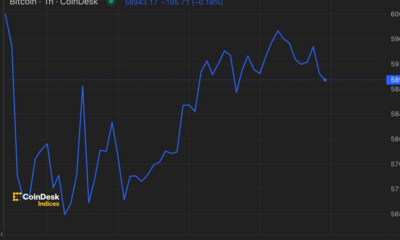Bitcoin
Bitcoin no Permiano? Data centers testam a rede do Texas.

A região petrolífera mais prolífica do país está se tornando um centro para indústrias que poderiam ser uma grande pressão sobre a rede elétrica do Texas: mineração de bitcoin e centros de dados.
A migração destas tecnologias para a Bacia do Permiano está a ocorrer à medida que a indústria do petróleo e do gás também tenta electrificar grande parte dos seus equipamentos para cumprir as metas de emissões líquidas zero, criando um conflito que poderá testar o já sobrecarregado sistema energético da região.
“É impressionante o quanto está vindo online, e não do petróleo e do gás”, disse Cyrus Reed, membro de um comitê estadual que estuda a demanda de eletricidade e diretor de conservação do capítulo Lone Star do Sierra Club. “É quase esmagador.”
A situação no Texas é emblemática não só de como a crescente procura de electricidade está a mudar a rede e a criar potenciais atrasos nas ligações a nível nacional, mas também sublinha quantas regiões há muito associadas à produção de petróleo e gás estão prestes a ser transformadas por novas tecnologias.
O Conselho de Confiabilidade Elétrica do Texas, principal operador de rede do estado, estima que a demanda de eletricidade das indústrias na região do Permiano mais que dobrará até 2030 em comparação com 2021, com as empresas consumindo 23.959 megawatts em horários de pico de demanda – mais energia do que todo o estado do Tennessee. gera durante períodos semelhantes.
Até 2030, a procura de electricidade proveniente de tecnologias emergentes poderá eclipsar a da indústria do petróleo e do gás na região. Espera-se que a maior parte dessa demanda – 58% – venha de operações de criptomineração, de acordo com a ERCOT. Actualmente, quase toda a procura de electricidade industrial no Permiano provém do petróleo e do gás.
A mudança está a levantar preocupações sobre como a região do Permiano será capaz de acompanhar o aumento da electricidade, especialmente em termos de adição de novas linhas de transmissão.
Todd Staples, presidente da Texas Oil and Gas Association, disse que a falta de transmissão já é um problema.
“Essa infraestrutura não está acompanhando e a necessidade de eletrificar essas operações tem [been an] problema contínuo desde que comecei na TXOGA há quase 10 anos”, disse ele. “O crescimento continuará e as empresas precisam de confiabilidade em suas fontes de alimentação.”
Para enfrentar a iminente crise da rede, os legisladores do Texas ordenaram em 2023 um estudo das necessidades de transmissão e geração no Permiano. Espera-se que um rascunho do estudo seja publicado em junho pela ERCOT.
Entre as questões que estão a ser examinadas está a quantidade de infra-estruturas electrificadas de petróleo e gás que conseguirão ligar-se à rede – especialmente as plataformas de fracking eléctrico, que utilizam, cada uma, tanta energia como uma pequena cidade.
Os membros do comité de planeamento regional que estuda o Permiano – que inclui responsáveis do petróleo e do gás, empresas tecnológicas, analistas do ERCOT e outros – também estão a examinar as necessidades de transmissão, mas existem numerosos desafios para a construção de mais infra-estruturas, incluindo financiamento adequado.
A ERCOT recusou-se a disponibilizar alguém para uma entrevista e, em vez disso, referiu-se a um comunicado de imprensa de abril sobre o planeamento do crescimento na rede do Texas como um todo.
“Como resultado do forte crescimento económico contínuo do Texas, novas cargas estão a ser adicionadas ao sistema ERCOT mais rapidamente e em maiores quantidades do que nunca”, disse o presidente e CEO da ERCOT, Pablo Vegas, no comunicado. “À medida que desenvolvemos e implementamos as ferramentas fornecidas pelas duas legislaturas anteriores, a ERCOT está posicionada para melhor planear e satisfazer as necessidades do nosso estado de crescimento incrivelmente rápido.”
A gigante de serviços públicos Oncor – que é responsável pela construção de linhas de transmissão na região – disse num comunicado que tem partilhado estudos independentes de crescimento da procura com a ERCOT, conversando com as indústrias sobre as suas necessidades de energia e começando a construir projectos de linhas eléctricas.
“A Oncor continuará a fazer a sua parte para apoiar os esforços para identificar as necessidades de crescimento, incorporá-las no planejamento de infraestrutura de longo prazo e garantir que a infraestrutura de distribuição elétrica do Texas acompanhe as necessidades da indústria hoje e nos próximos anos”, disse o porta-voz da Oncor. Connie Piloto.
Uma vitória para as usinas a gás?
Outras indústrias que deverão colocar pressão sobre a rede do Permiano incluem o hidrogénio “verde”, que deverá constituir 22% da procura de electricidade não petrolífera e de gás até 2030, de acordo com o ERCOT. Prevê-se que as minas criptográficas exijam ainda mais energia, atingindo mais de 6.957 MW de demanda até o final da década.
Ryan Luther, diretor de pesquisa de transição energética da Enverus, disse que sua empresa rastreou uma mudança nas operações de criptomineração da China para o oeste do Texas, que proibiu a tecnologia em 2021. A migração está sendo impulsionada em parte pela busca por gás natural barato para energia.
“Eles estão tentando encontrar gás encalhado que não consegue chegar ao mercado”, disse ele sobre as empresas de criptografia.
A razão pela qual muitos estão a dirigir-se para o Permiano é porque os produtores estão à procura de formas de reduzir as emissões, deixando de libertar ou queimar o excesso de gás natural que sobra da produção de petróleo e, em vez disso, oferecendo o combustível para a electricidade. Os promotores de petróleo e gás foram pressionados a mudar as suas práticas, em parte pela EPA, que finalizou várias regras nos últimos meses para reduzir as emissões de metano.
Entre elas está uma taxa de US$ 900 por cada tonelada de metano que os operadores de petróleo e gás liberam ou queimam durante situações não emergenciais. A taxa deverá aumentar para US$ 1.500 por tonelada em 2026.
A utilização do excesso de gás para a produção de energia é uma das poucas alternativas à queima, especialmente porque existem limitados gasodutos no Permiano para levar o excesso de combustível para mercados maiores, como a Costa do Golfo.
“Os produtores do Permiano preferem ver a procura do seu gás crescer na bacia do que ter de construir mais gasodutos. O seu principal objectivo é levar o petróleo ao mercado – o gás não está tanto no mix de valor”, disse Luther.
O presidente executivo da Kinder Morgan, Richard Kinder, por exemplo, disse aos analistas na teleconferência de resultados do primeiro trimestre da empresa que as principais empresas de tecnologia com inteligência artificial e data centers vão querer se localizar o mais próximo possível das fontes de combustível, incluindo o gás natural.
“A energia necessária para a IA e os enormes centros de dados que estão a ser construídos hoje e planeados para o futuro próximo exigem eletricidade acessível e disponível sem interrupção, 24 horas por dia, 365 dias por ano”, disse ele. “E acho que tenderá a estar localizado perto de geração elétrica confiável, porque se você é um Microsoft ou um Google, você quer essa energia o mais próximo possível de suas instalações.”
Ainda assim, a utilização de gás para produzir energia em vez da sua ventilação ou queima pode ser controversa entre os grupos ambientalistas, disse Doug Lewin, fundador e presidente da consultoria Stoic Energy. “Muita gente não vai gostar, mas ventilar e queimar é muito pior [for emissions] do que usar [gas] pelo poder.”
A região do Permiano também é um centro de energia eólica, solar e de baterias, ajudando a tornar o Texas a capital renovável dos Estados Unidos. A região pode produzir 11.747 MW de energia nos horários de pico apenas a partir da energia eólica e solar, o suficiente para abastecer a cidade de Nova Iorque mais do dobro, de acordo com a ERCOT.
Grande parte da energia disponível fica presa no oeste do Texas devido a restrições de transmissão, proporcionando outro incentivo para que empresas ávidas por energia se mudem para a região.
“Acho que se você é um data center de IA em busca principalmente de energia limpa com algum gás de reserva por perto, não consigo imaginar muitos lugares melhores no país para ir do que o Permiano”, disse Lewin. “Você pode estar 70 a 80% livre de carbono e usar gás nas outras vezes.”
Lewin disse que estava mais cético em relação à quantidade de demanda da criptomineração que poderia realmente ficar online, uma visão compartilhada por Lee Bratcher, presidente do Texas Blockchain Council, um grupo do setor.
Embora haja quase 7.000 MW de demanda de aplicações de criptomineradores somente no Permiano, alguns desses projetos não serão concretizados, disse Bratcher.
“Muitas dessas estimativas são superestimativas significativas, acho que o ERCOT sabe disso, mas eles têm que incluí-las porque há inscrições na fila”, disse Bratcher.
Também não há “dólares de investimento suficientes para construir tanta infra-estrutura, por isso prevemos um crescimento bastante constante de cerca de 300 MW por trimestre de mineração de bitcoin, que se estabilizará para muito menos do que isso depois de um ou dois anos. Nunca prevemos mais de 5.000 MW de mineração de bitcoin no Texas”, disse Bratcher. Esse nível de mineração de bitcoin poderia manter o petróleo e o gás como o consumidor dominante de eletricidade na região.
Bratcher acrescentou que o bitcoin tem limites de crescimento por causa de sua economia, que segue o princípio de que quanto mais mineradores ficam online, menos lucrativa cada unidade se torna.
Óleo elétrico
Mesmo que o bitcoin não cresça tanto quanto o esperado, a rede do Permiano enfrenta uma grande pressão devido às empresas de petróleo e gás que electrificam as suas frotas para ajudar a cumprir as metas de emissões.
A Exxon Mobil, por exemplo, comprometeu-se a atingir zero emissões líquidas nas suas operações no Permiano até 2030, em grande parte através da electrificação de equipamentos que actualmente funcionam com combustíveis fósseis. A Chevron comprometeu-se a atingir zero emissões líquidas na sua produção global de petróleo e gás até 2050.
A Occidental Petroleum anunciou no início deste ano que contratou a Axis Energy Services para implantar sua primeira plataforma de serviço de poço totalmente elétrica, que realiza manutenção frequente nos equipamentos. A plataforma EPIC da empresa precisa de no máximo 1,25 MW para funcionar, eletricidade suficiente para abastecer cerca de 250 residências em um dia quente de verão.
Clay Holland, vice-presidente sênior de operações da Axis, disse que as vantagens da tecnologia elétrica vão além dos compromissos ambientais, sociais e de governança e do marketing das empresas de petróleo e gás. As plataformas de serviço de poços mais antigas, que funcionavam com a queima de diesel, tinham sistemas de freios “antigos” e eram propensas a falhas de equipamento.
Também há economia de custos. Comprar e transportar 150 galões de diesel por dia para operar as plataformas tradicionais de serviço de poço é caro, especialmente quando multiplicado por plataformas em uma enorme área geográfica.
“É necessário mais investimento para plataformas EPIC com base na taxa diária, mas mesmo com taxas diárias mais altas, a eficiência obtida com menos manutenção e menos tempo de inatividade relacionado à segurança – isso gera economias de custos significativas”, disse Holland. “Você pode acompanhar o dólar e descobrir por que ele é vantajoso; o que temos visto na indústria é que se ela não ganhar dólares e centavos, as pessoas fugirão dela.”
Outras máquinas eletrificadas utilizam quantidades muito maiores de energia do que as plataformas de serviço. As plataformas de fracking elétrico, que lançam fluidos profundamente abaixo da superfície da Terra para quebrar rochas a fim de extrair mais petróleo e gás, podem usar mais de 25 MW – eletricidade suficiente para abastecer mais de 6.250 residências em horários de pico de demanda no Texas.
Mas as plataformas de serviço e outros grandes equipamentos no Permiano não são estacionários, tornando mais difícil localizar projetos de transmissão.
Conectar equipamentos como plataformas elétricas de fraturamento hidráulico à rede e aproveitar o abundante suprimento de energia renovável do oeste do Texas poderia ser quase impossível, de acordo com Luther. Isso ocorre principalmente porque as plataformas se movem de poço em poço com frequência, uma vez que terminam o fraturamento hidráulico em um determinado local.
“No setor de energia, você não construirá transmissão a menos que veja uma vida útil de 50 anos nessa linha”, disse Luther. “Frotas de fracking elétrico [are] não estarão conectados porque eles vão se movimentar.”
Bratcher, do Texas Blockchain Council, disse que os mineiros têm oferecido garantias para construir mais transmissão no Permiano, acrescentando que não vê a demanda por eletricidade como uma competição entre criptografia, petróleo e gás.
“A indústria de petróleo e gás tem sido ótima para o Texas há muito tempo”, disse Bratcher. “A mineração de Bitcoin é uma nova indústria que criará empregos rurais, como o petróleo e o gás têm feito há décadas, e de uma forma única.”
Contudo, não existe um roteiro para uma construção massiva de infra-estruturas de transmissão e de novas centrais eléctricas na região num período de tempo tão curto.
“Tudo isso é meio novo porque poucas pessoas fizeram isso ainda”, disse Lewin.
Bitcoin
Bitcoin (BTC) Price Drops Below $65K After FOMC as Middle East Tensions Rise

Cryptocurrencies fell sharply on Wednesday as rising geopolitical risks captivated investors’ attention following the conclusion of the Federal Reserve’s July meeting.
Bitcoin (BTC) fell to $64,500 from around $66,500, where it traded following Federal Reserve Chairman Jerome Powell’s press conference and is down more than 2% in the past 24 hours. Major altcoins including ether (ETH)sunbathing (SUN)Avalanche AVAX (AVAX) and Cardano (ADA) also fell, while Ripple’s XRP saved some of its early gains today. The broad cryptocurrency market benchmark CoinDesk 20 Index was 0.8% lower than 24 hours ago.
The liquidation happened when the New York Times reported that Iran’s leaders have ordered retaliation against Israel over the killing of Hamas leader Ismail Haniyeh in Tehran, raising the risk of a wider conflict in the region.
Earlier today, the Fed left benchmark interest rates unchanged and gave little indication that a widely expected rate cut in September is a given. The Fed’s Powell said that while no decision has been made on a September cut, the “broad sense is that we are getting closer” to cutting rates.
While digital assets suffered losses, most traditional asset classes rose higher during the day. U.S. 10-year bond yields fell 10 basis points, while gold rose 1.5% to $2,450, slightly below its record highs, and WTI crude oil prices rose 5%. Stocks also rallied during the day, with the tech-heavy Nasdaq 100 index rebounding 3% and the S&P 500 closing the session 2.2% higher, led by 12% gains in chipmaker giant Nvidia (NVDA).
The different performances across asset classes could be due to traders’ positioning ahead of the Fed meeting, Zach Pandl, head of research at Grayscale, said in an emailed note.
“Equities may have been slightly underutilized after the recent dip, while bitcoin is coming off a strong period with solid inflows, while gold has recovered after a period of weakness,” he said.
“Overall, the combination of Fed rate cuts, bipartisan focus on cryptocurrency policy issues, and the prospect of a second Trump administration that could advocate for a weaker U.S. dollar should be viewed as very positive for bitcoin,” he concluded.
UPDATE (July 31, 2024, 21:30 UTC): Adds grayscale comments.
Bitcoin
No, Bitcoin Will Not Solve Our National Debt

Wyoming Republican Senator Cynthia Lummis speaks at the Bitcoin 2024 conference in … [+] Nashville, Tennessee, U.S., on Saturday, July 27, 2024. Former U.S. President Donald Trump said he would fire the chairman of the Securities and Exchange Commission and pick crypto-friendly regulators if he returns to the White House in a bid to woo virtual currency enthusiasts and capitalize on the industry’s growing influence in the political arena. Photographer: Brett Carlsen/Bloomberg
© 2024 Bloomberg Finance LP
At a Bitcoin conference last weekend, Senator Cynthia Lummis (R-Wyo.) announced future legislation that would direct the Treasury to purchase 1 million Bitcoin, or roughly 5% of the global supply, over five years (which would cost between $60 billion and $70 billion at today’s prices). Lummis claimed that the federal government would be “debt-free because of Bitcoin” if his proposal were to pass, because these Bitcoins could be sold by the federal government at a profit after 20 years. Unfortunately, there are mathematical and conceptual problems that prevent such an approach from solving the federal government’s budget problems.
Let’s start with the math: US National Debt Today stands at nearly $28 trillion (or $35 trillion if you include the “intragovernmental debt” that the general fund owes to other internal government accounting entities, such as the Social Security and Medicare trust funds). This year alone, the federal government spent about $2 trillion more than it took in in revenue, which had to be covered by borrowing money that adds to our national debt.
In comparison, the total market capitalization of Bitcoin today (which is the total number of Bitcoins in existence multiplied by their current market price) is only about $1.3 trillion — and that’s with Bitcoin’s current price near its all-time high. If all the Bitcoin in the world isn’t worth enough to cover a single year’s budget deficit, there’s no way buying 5% of it could plausibly stem the growth of, let alone pay off, our national debt. For the math to work, Bitcoin’s market cap would have to reach a level that is a multiple of the annual economic output of the entire planet (the International Monetary Fund current estimates the sum of each country’s gross domestic product is less than US$110 trillion).
But beyond the math, there are serious conceptual problems with Lummis’s proposal as a partial solution. When the government acquires an asset, it is typically reallocating rather than creating wealth. As the government buys some of the existing supply of Bitcoin, it would reduce the remaining supply available for others to buy on the market. If private demand for Bitcoin remains constant, the result would be an increase in the price of one Bitcoin. The beneficiaries of this transaction would be the current owners of Bitcoin (one of whom is Senator Lummis herself), because they would be in possession of an asset that can be sold at a higher price than the price at which it was originally purchased.
The increase in Bitcoin’s price, and thus the financial benefit to current holders, is likely to be even greater because, rather than remaining constant, private demand would increase as previously cautious investors view the U.S. government’s investment as an indicator of the digital asset’s legitimacy. These higher prices would not only increase demand for Bitcoin, but could also encourage Bitcoin “miners” to increase supply. Bitcoin mining is a extremely energy intensive process that relies on advanced graphics processing units (GPUs). If Bitcoin mining increases demand for GPUs, the GPUs themselves will become more expensive, as they did in 2020. In turn, every activity that depends on GPUs — from video editing to gaming — will also become more expensive.
Perhaps most alarmingly, a boom in Bitcoin mining threatens to stifle promising developments in artificial intelligence (AI). As other Forbes contributors point out, he wroteAI has the potential to revolutionize our economy and boost the productivity of our workforce in countless ways that would increase real wealth for Americans of all socioeconomic backgrounds. But AI also relies on advanced GPUs to function, of which there are already there is not enough supply to meet demand. It would be a profound failure of federal policy to make AI advances more costly to achieve by encouraging people to spend the resources needed to generate digital tokens. Furthermore, even if federal government Bitcoin purchases do not lead to an increase in Bitcoin mining, there are still other ways in which rising Bitcoin prices would displace productive economic investment — but rather than delve into them here, I recommend reading this great 2022 article by Josh Barro about the subject.
For these and other reasons, the federal government should not take any action to push the price of Bitcoin — or any other cryptocurrency, for that matter — above the level set by the free market. If policymakers believe that prices will continue to rise anyway and want to capture some of that value for deficit reduction, there are much better mechanisms for doing so. For example, a capital gains tax increase could aim to capture 5% of the gain on 100% of Bitcoin rather than capturing 100% of the gain on 5% of Bitcoin, as the Lummis proposal would seek to do. In addition to avoiding the market-distorting effects of the Lummis proposal, this approach has the added benefit of not leaving taxpayers holding the bag if the value of Bitcoin plummets, as then many other cryptocurrencies have done.
When it comes to dealing with our national debt, there is no substitute for cutting spending and/or raising taxes. There are no quick fixes here — policymakers must accept tradeoffs and make hard choices about how to allocate limited resources. Fortunately, my team at the Progressive Policy Institute recently published a serious package of proposals that deals with these tradeoffs to put the federal budget on a path to balance within 20 years. Even adopting half of our recommended savings would allow policymakers to keep debt from growing faster than our economy, which is what most economists consider to be the measure of fiscal sustainability. And ours is just one framework: six other think tanks published their own plans to stabilize the debt last week (and notably, none of them proposed spending up to $70 billion of taxpayer funds on Bitcoin).
To Senator Lummis’s credit, she has also supported efforts to promote serious solutions like these in the past. As a member of the U.S. House of Representatives in 2012, Lummis was one of only 38 members who resisted partisan pressure and voted in favor of a congressional budget resolution based on the debt stabilization recommendations of the bipartisan Simpson-Bowles Fiscal Commission. More recently, Lummis was one of nine senators to cosponsor a bill that would establish another bipartisan fiscal commission to generate an updated package of recommendations to stabilize the national debt. It would be a great service to the nation if Senator Lummis would put all her energy into advancing these and other serious efforts to align revenues and spending rather than distracting them with alternative schemes that would merely enrich cryptocurrency investors at the expense of the taxpayer.
Bitcoin
Bitcoin Falls as ETF Flows Reverse, Mt. Gox Moves Billions

In a week of drastic fluctuations, the price of Bitcoin (BTC) has retreated from its highs and is currently trading at US$66,250, down 0.9% in European trading.
This volatility comes on the heels of a significant surge above $70,000 earlier in the week, fueled by former President Donald Trump’s ambitious cryptocurrency plans announced in a Bitcoin Conference in Nashville.
Trump’s announcement to fire Securities and Exchange Commission Chairman Gary Gensler and establish a strategic Bitcoin reserve if elected president has temporarily sent the cryptocurrency market into a frenzy.
However, the excitement was short-lived as a series of events unfolded which caused investor sentiment to sour.
A significant sell-off of about 8% was triggered when the US Marshals Service moved $2 billion in Bitcoin for new wallets.
This move has reignited fears of a potential large-scale liquidation, compounded by lingering concerns over a possible Bitcoin liquidation from Mt. Gox. Early this morning, Mt. Gox administrator transferred US$2.2 billion value of your BTC assets in a new wallet.
Meanwhile, the US Bitcoin ETF spot market is showing signs of fluctuation, according to data from SoSo Value. On July 30, Bitcoin spot funds experienced their first net outflow in five days, totaling $18.3 million.
The Grayscale Bitcoin Trust (GBTC) saw outflows of $73.6 million, while the BlackRock iShares Bitcoin Trust (IBIT) attracted $74.9 million in inflows. But outflows from other funds left the category in the red at the end of Tuesday’s trading session. The total net asset value of spot Bitcoin ETFs currently stands at a substantial $58.5 billion.
In other crypto news, Ripple (XRP) is up 8.6% in the past 24 hours, hitting over 64 cents – its highest point since March 25, according to CoinGecko. data.
This rally comes amid a scheduled token unlock and growing optimism around a potential deal in the long-running SEC vs. Ripple lawsuit.
The crypto community is closely watching the SEC’s actions, particularly its intention to amend its complaint against Binance regarding “Third-Party Cryptocurrency Securities,” which some interpret as a positive sign for Ripple.
On a market analysis noteSingapore-based cryptocurrency trading desk QCP Capital wrote that while election headlines continue to dominate, several crucial macroeconomic events loom on the horizon.
“Election headlines will continue to be a key focus, but several key macroeconomic events are also on the horizon. Key events starting with the FOMC meeting on Wednesday, megacap tech earnings (Apple, Amazon, Meta) throughout the week, and unemployment data on Friday,” QCP Capital wrote.
Edited by Stacy Elliott.
Bitcoin
1 Top Cryptocurrency That Could Surge Over 4,300%, According to This Wall Street Firm

This bold prediction that Bitcoin will hit $2.9 million by 2050 could redefine your investment strategy.
In a groundbreaking report, VanEck, a leading investment management firm, has set the stage for an extraordinary prediction about Bitcoin‘s (BTC -2.63%) in the future. According to their analysis, Bitcoin could potentially reach a staggering $2.9 million by 2050, marking an astronomical increase of over 4,300% from its current price.
This bold prediction is more than just a headline-grabbing attempt. The report is packed with information across its 20+ pages, and includes plenty of evidence and hypotheses to support its claims. Luckily, I read the whole thing, so you don’t have to. In this article, we’ll explore the key elements of VanEck’s report, deciphering why Bitcoin’s value could skyrocket to such heights and what it means for investors and the financial world at large.
Image source: Getty Images.
Unpacking the VanEck Report
VanEck’s analysis outlines three scenarios for predicting Bitcoin’s future value: the bearish case, the base case, and the bullish case. Each scenario provides a different perspective on how Bitcoin may evolve based on various economic and technological factors, and of course, where its price may be headed.
To arrive at these conclusions, VanEck’s valuation model relies on a combination of historical data, current market trends, and future financial developments. This comprehensive approach aims to assess Bitcoin’s potential as a medium of exchange and reserve asset. With that out of the way, let’s move on to the scenarios.
Bear scenario
In the pessimistic case, Bitcoin’s value is expected to remain relatively stagnant, reflecting limited growth due to regulatory hurdles, technological limitations, or broader economic challenges.
This scenario assumes that Bitcoin will not achieve widespread adoption and will face significant competitive threats from other digital currencies or innovations. If this is the path Bitcoin takes, VanEck predicts that Bitcoin will only reach $130,314 by 2050. This equates to a measly 2.6% compound annual growth rate (CAGR).
Base scenario
The base case presents a more balanced view, where Bitcoin’s value is influenced by moderate adoption and integration into the existing financial system. However, even though it is called the base case, it is still extremely bullish.
This analysis predicts that Bitcoin will reach a price of $2,910,345 and solidify itself as a viable digital asset, resulting in a stronger CAGR of close to 15.7%. Driving this adoption are a multitude of factors, such as rising government debt around the world, reduced use of fiat currenciesbetter technology that makes Bitcoin faster and cheaper to use, and the possibility of Bitcoin becoming the world’s reserve currency.
Bullish scenario
The bullish scenario is the most optimistic, predicting that Bitcoin’s value could reach a staggering $52,386,207 by 2050. Here, Bitcoin’s CAGR rises to 29.3%.
This extreme growth projection is based on Bitcoin achieving widespread adoption as a medium of exchange and a reserve asset. It considers advances in blockchain technology, significant macroeconomic changes, and increased institutional investment. In short, this scenario basically assumes that the world will undergo hyper-Bitcoinization very quickly.
How Bitcoin Could Reach $2.9 Million
While the bear and bull scenarios are unlikely outliers on either end of the spectrum, it’s worth examining the reasoning behind VanEck’s base result in greater detail. This intermediate target strikes a valuable middle ground and does a good job of capturing what makes Bitcoin so unique.
The first catalyst that could send Bitcoin to nearly $3 million is increased adoption as a medium of exchange. As the world and its financial system become more digitized, there is a clear path where Bitcoin could gain traction as a popular medium of exchange. The decentralized nature of the cryptocurrency, coupled with its growing acceptance among merchants and consumers, supports its potential to become a mainstream payment method. If Bitcoin’s use as a transactional currency becomes widespread, VanEck suggests that its value could appreciate significantly.
At a more granular level, technological advancements are critical drivers of Bitcoin’s future valuation. For most of Bitcoin’s existence, its blockchain was more than capable of handling transactions cost-effectively. However, as the years have passed and it has processed more transactions, there has been a need to find a method for Bitcoin to scale efficiently.
Fortunately, there are a number of solutions in development that attempt to make Bitcoin faster and cheaper to use, such as Lightning Network and layer 2 blockchains like Stacks (STX -3.26%). VanEck believes that if Bitcoin is able to scale properly, it will only bolster the cryptocurrency’s prospects following the base case trajectory.
Expanding a bit, VanEck posits that Bitcoin could become a global reserve asset, similar to gold, as institutional investors and nations seek a stable store of value in a turbulent economic landscape. As VanEck’s report outlines, the global financial world is currently in a state of flux.
The currencies of the most prosperous economies (the US, EU, Japan and the UK) are starting to be used less for international payments. Furthermore, these economies, which dominated for much of the last century, face a growing debt burden that could further erode the value of their currencies. VanEck’s report predicts that as this trend worsens, other nations will turn to Bitcoin due to its apolitical construction and robust fundamentals that prioritize value preservation. When all is said and done, Bitcoin could become the world’s global reserve currency, causing its price to soar as governments clamor for a share of its finite supply.
Last food for thought
VanEck’s prediction that Bitcoin could rise to over $2.9 million by 2050 represents a bold and optimistic outlook for the cryptocurrency. It may sound sensationalist, but keep in mind that virtually no one could have imagined that Bitcoin would rise from just a few cents to over $60,000 over the past 15 years.
However, as appealing as this may sound, a bit of restraint is in order. No one has a crystal ball, and while the outlook is promising, investors should carefully weigh the rewards against the risks and, more importantly, Approaching Bitcoin with a long-term perspective.
But for those who believe in its future potential, have an appetite for risk, and are comfortable holding for the long term, Bitcoin’s current value could represent an attractive entry point. See you in 2050.
-

 News1 year ago
News1 year agoBitcoin (BTC) price recovery faces test on non-farm payrolls
-

 Bitcoin12 months ago
Bitcoin12 months ago1 Top Cryptocurrency That Could Surge Over 4,300%, According to This Wall Street Firm
-

 Altcoins12 months ago
Altcoins12 months agoOn-chain data confirms whales are preparing for altcoin surge with increased buy orders
-

 Bitcoin12 months ago
Bitcoin12 months agoThe US government may start accumulating Bitcoin, but how and why?
-

 News1 year ago
News1 year agoNew ByBit Listings for 2024: 10 Potential Listings
-

 News1 year ago
News1 year ago11 Best Crypto TikTok Accounts & Influencers in 2024
-

 News1 year ago
News1 year ago11 Best Shitcoins to Buy in 2024: The Full List
-

 Altcoins1 year ago
Altcoins1 year agoMarket giants have taken action!
-

 Ethereum1 year ago
Ethereum1 year agoTop Meme Coins by Market Capitalization in 2024
-

 News1 year ago
News1 year ago1.08 Trillion SHIBs Dumped on Major Crypto Exchange, What’s Going On?
-

 News1 year ago
News1 year ago19 Best Crypto Games to Play in 2024
-

 Altcoins1 year ago
Altcoins1 year agoAltcoin Recommended by Crypto Expert for Today’s Portfolio





